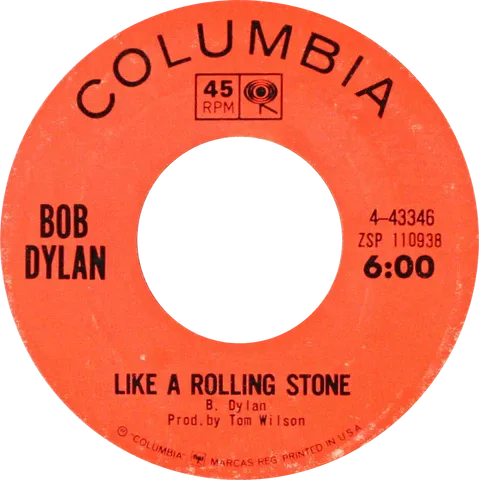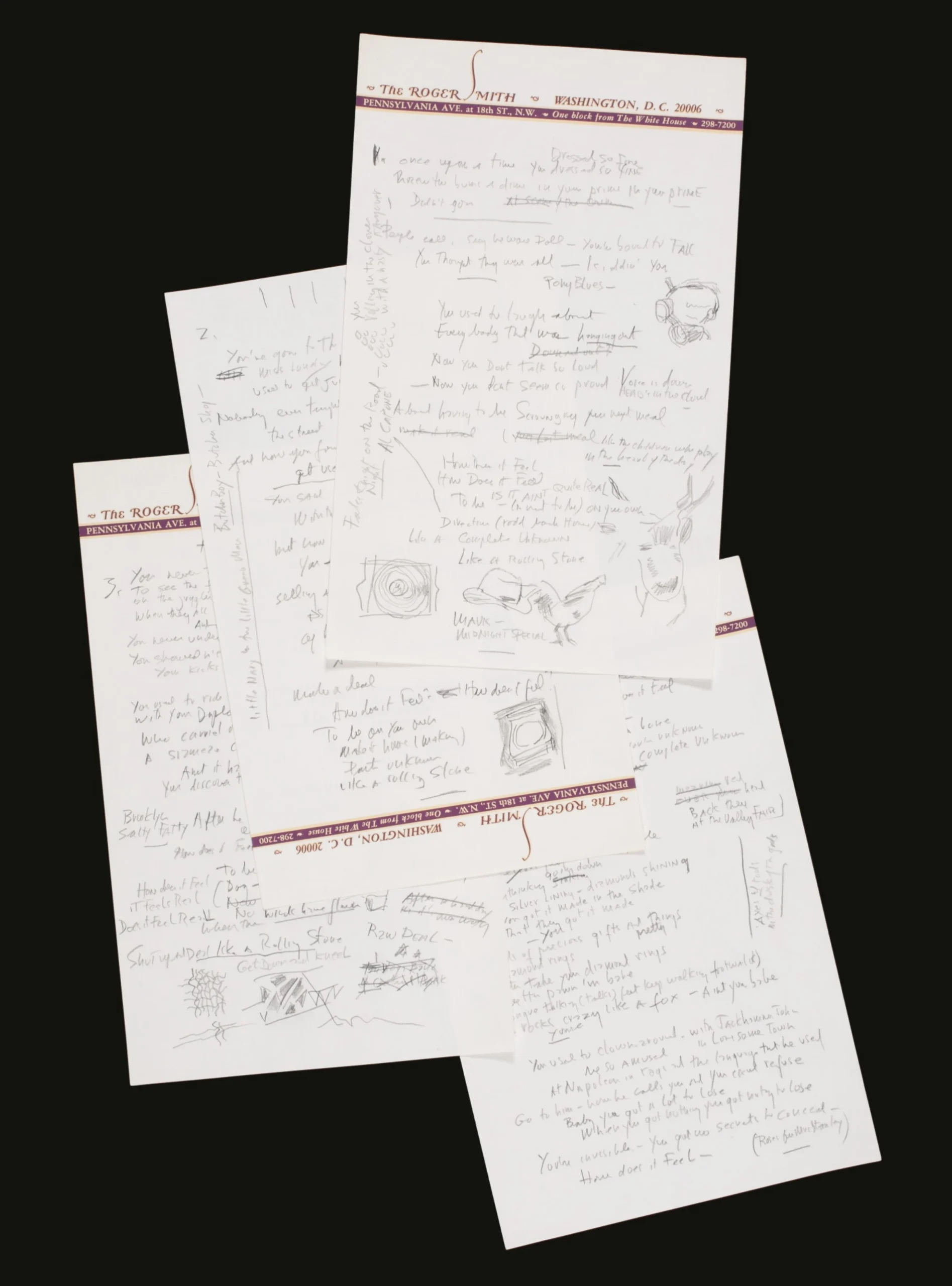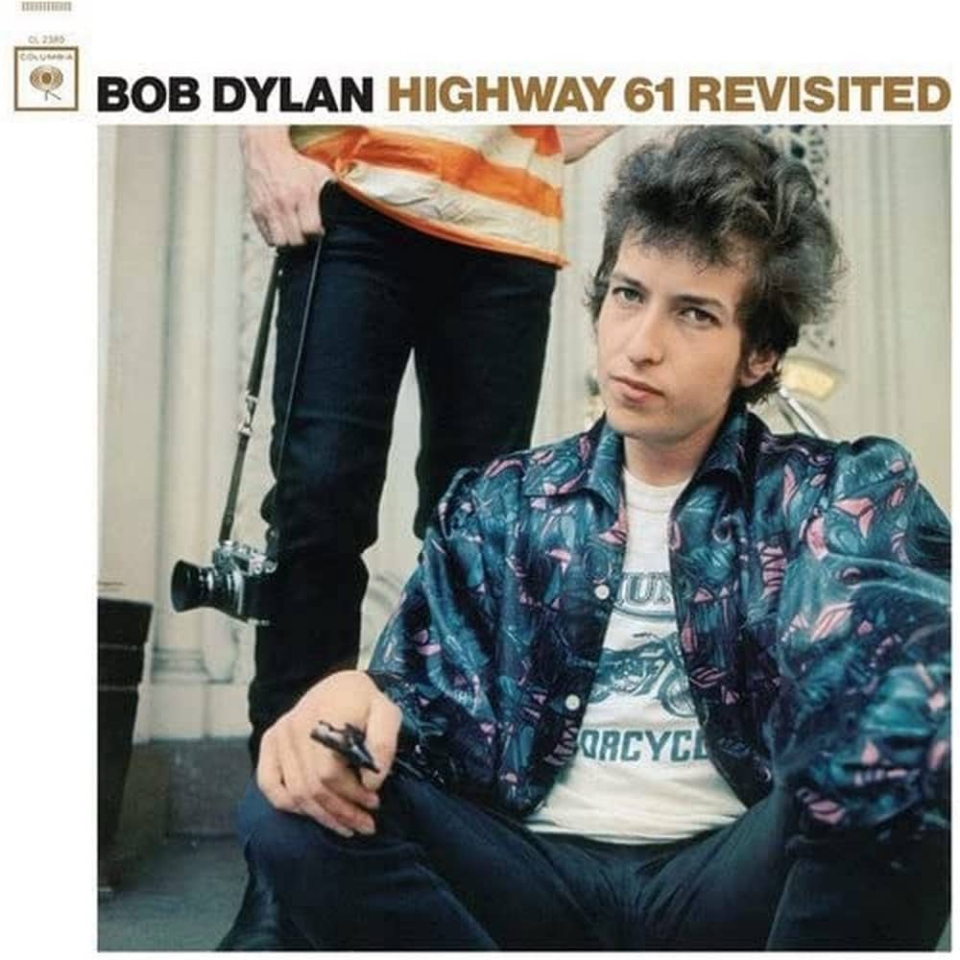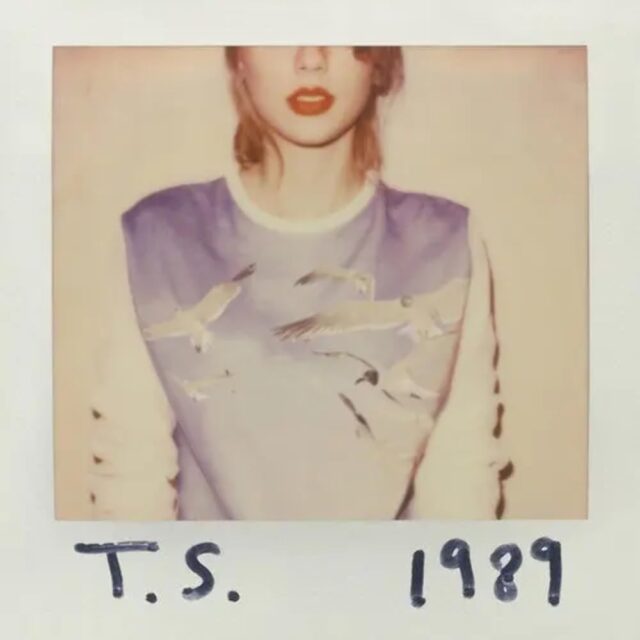How does one begin to understand what is considered to be the greatest song ever written?
Bob Dylan’s “Like a Rolling Stone” was released as a single on July 20th, 1965, with “Gates of Eden” as the B-side. The single came out before the album Highway 61 Revisited, which was released on August 30th, 1965.
“Like a Rolling Stone” is widely regarded as one of the most influential songs in music history. Highway 61 Revisited marked an evolution for Dylan as he shifted from his acoustic roots and embraced electricity in his sound, surprising some with a bolder, uncharted style. This challenged expectations in the genre and helped shape the future of folk.

The greatest song almost never happened. Shaun saved it.
Dylan wrote the lyrics of “Like A Rolling Stone” on letterhead from the Roger Smith Hotel in Washington, D.C. The recording session took place over two days, June 15 and 16, 1965, at Studio A of the New York headquarters of Columbia Records at 799 Seventh Avenue. Of the 15 takes recorded, it was the fourth take from the second day that was chosen as the final version for release.
When the edited tape was played for Dylan and his manager, they immediately agreed it would be a hit. However, Columbia’s sales and marketing team initially opposed releasing the song due to its six-minute length, which was far longer than the typical three-minute singles. A memo was sent out by the sales team stating the song was to be moved from an “immediate special” to an “unassigned release,” unsure of when a release date would happen.
At the time, Columbia Records was moving into its parent company CBS’s new building on Sixth Avenue and informed staff that clutter would not be allowed at the new location and to discard unimportant items. Shaun Considine, a coordinator of new releases for the label, recalled, “During my last trek through what remained of the A&R department, I was invited to sort through a stack of records and demos that were to be junked. Among them I discovered a gem: a studio-cut acetate of ‘Like a Rolling Stone.’ Carefully packing it into an empty LP jacket, I carried it home and that weekend played it more than once in my apartment. The effect was the same as it had been the first time I had experienced it. Exhilaration. Heart pounding. Body rolling — followed by neighbors banging on the walls in protest. Then, on Sunday evening, it came to me. I knew exactly where the song could be fully appreciated.”
Considine decided to see if amplifying what he felt was possible and took the song to “Arthur” on East 54th Street in Manhattan, which was the “hottest new disco.” Considine stated, “The D.J. was very polite when asked if he would kindly play the acetate during a free moment.” Considine added that he didn’t mention the artist, but noted that the song was “rather long and that he should feel free to stop it if the dancers got bored or tired.” “At around 11 p.m., after a break, he played the acetate. The effect was seismic. People jumped to their feet and took to the floor, dancing the entire six minutes. Those who were seated stopped talking and began to listen. ‘Who is it?’ the D.J. yelled at one point, running toward me. ‘Bob Dylan!’ I shouted back. The name spread through the room, which only encouraged the skeptics to insist that it be played again, straight through. Sometime past midnight, as the grooves on the temporary dub wore out, the needle began to skip,” said Considine.
The next day, on Monday, staff meetings were quickly called as radio stations, most notably WMCA and WABC, demanded to know when their copy of the new Bob Dylan record was arriving. On July 15, a month after its recording, “Like a Rolling Stone” shipped to stores and D.J.s, with the official release day of Tuesday, July 20, 1965.
The shockwave of an electric Dylan
Bob Dylan first performed ‘Like a Rolling Stone’ in public on July 25, 1965, at the Newport Folk Festival in Newport, Rhode Island. Dylan, backed by the Paul Butterfield Blues Band, shocked the crowd by playing with an electric guitar.
Many fans were upset and booed because they felt he had left his folk roots behind and ‘sold out’ to rock music. Others listened. Others didn’t know what to do.
Dylan played ‘Like a Rolling Stone’ as the second song in his set. This came right after the boos from ‘Maggie’s Farm’ and before ‘Phantom Engineer.’ Dylan then left the stage and returned with his acoustic guitar to perform ‘It’s All Over Now, Baby Blue’ and ended with the crowd cheering to ‘Mr. Tambourine Man.’
During a televised press conference in San Francisco on December 3, 1965, Dylan was asked by a reporter, ‘Do you still sing your older songs?’ To which he replied: “No, I just saw a songbook last night. I don’t really see too many of those things, but a lot of songs in those books I haven’t even recorded. Hmm… I’ve just written them down, you know, put new tunes to them, and they’re published, and I haven’t sung them. A lot of the songs I just don’t need to know anymore, even the ones that I did sing. There doesn’t seem to be enough time, you know.”
At the same press conference, Dylan said, “The words are just as important as the music; there’d be no music without the words.”
Reflecting on the Newport Folk Festival experience, Dylan stated in an interview with Playboy in March 1966 that he was tired of his acoustic material and considered quitting music altogether. “I was going to quit singing. I was very drained, and the way things were going, it was a very draggy situation… I was playing a lot of songs I didn’t want to play. I was singing words I didn’t really want to sing. It’s very tiring having other people tell you how much they dig you if you yourself don’t dig you.”

Lyrically: Like A Rolling Stone by Bob Dylan
‘Like a Rolling Stone tells the story of a person’s fall from grace and their harsh awakening to reality. The song is widely believed to be inspired by Edie Sedgwick, one of Andy Warhol’s Superstars who popularized the mini skirt and reportedly had a brief relationship with Dylan around 1965. While the identity of the song’s subject remains debatable, Dylan is directly addressing “Miss Lonely,” a fictional character who serves as a mirror in which those listening can see the message being reflected.
Once upon a time you dressed so fine
Threw the bums a dime in your prime, didn’t you?
People call say ‘beware doll, you’re bound to fall’
You thought they were all kidding you
You used to laugh about
Everybody that was hanging out
Now you don’t talk so loud
Now you don’t seem so proud
About having to be scrounging your next meal
Dylan’s opening describes someone who once lived a wealthy, carefree life. Now, they look back and question their choices.
During a 1966 interview with Jules Siegel from The Saturday Evening Post titled Bob Dylan: ‘Well, What Have We Here?,’ Dylan stated, “It was 10 pages long… It wasn’t called anything, just a rhythm thing on paper all about my steady hatred directed at some point that was honest… Revenge, that’s a better word. I had never thought of it as a song, until one day I was at the piano, and on the paper it was singing, ‘How does it feel?’ in a slow motion pace, in the utmost of slow motion following something. I wrote it. I didn’t fail. It was straight.”
How does it feel, how does it feel?
To be without a home
Like a complete unknown, like a rolling stone
The chorus is song-writing at its finest, with Dylan stating, “How does it feel / To be on your own, with no direction home / Like a complete unknown, like a rolling stone?” This reinforces the song’s central question: What happens when all familiar comforts disappear? The words “on your own,” “a complete unknown” and “no direction home” speak to a loss of purpose.
The verse, “Ahh you’ve gone to the finest schools, alright Miss Lonely / But you know you only used to get juiced in it,” suggests that Miss Lonely wasted her elite education. She learned no real-life skills.
Nobody’s ever taught you how to live out on the street
And now you’re gonna have to get used to it.You say you never compromise
With the mystery tramp, but now you realize
He’s not selling any alibis
As you stare into the vacuum of his eyes
And say do you want to make a deal?
With every listen, this song deepens. This hints at a fall from comfort and status. The “mystery tramp” with “the vacuum of his eyes” is the flip side of the secure world she once knew, now symbolizing emptiness and doubt. The lyric “And say do you want to make a deal?” reveals Miss Lonely’s current fate of an uncertain future. She is now bargaining and “making a deal.”
Dylan once described Like a Rolling Stone as “I wrote that after I had quit. I’d literally quit singing and playing, and I found myself writing this song, this story, this long piece of vomit about twenty pages long and out of it I took ‘Like a Rolling Stone’ and made it as a single. And I never written anything like that before and it suddenly came to me that this is what I should do.”
Ah you never turned around to see the frowns
On the jugglers and the clowns when they all did tricks for you
You never understood that it ain’t no good
You shouldn’t let other people get your kicks for you
You used to ride on a chrome horse with your diplomat
Who carried on his shoulder a Siamese cat
These lyrics see Miss Lonely fall from privilege. Once, she was surrounded by “jugglers and clowns” who entertained her. She failed to notice the “frowns” and discontented faces of those people. Dylan shows the emptiness of living through others and using people for gain.
The “chrome horse” and “diplomat” with a “Siamese cat” represent her former world, revealing how wealth and false friends are merely a facade of power.
Ain’t it hard when you discovered that
He really wasn’t where it’s at
After he took from you everything he could steal
Here, Dylan is almost empathetic within his critique. These stark lyrics are widely interpreted as a nod to Edie Sedgwick. They may reference her relationship with Andy Warhol, who was obsessed with creating celebrity personas but often abandoned when the fame faded.
Dylan never confirmed a link to Sedgwick. But, the parallels between the lyrics and her story with Warhol make it a compelling. In the Playboy interview, Dylan said, “…It wasn’t called anything, just a rhythm thing on paper all about my steady hatred directed at some point that was honest. In the end it wasn’t hatred, it was telling someone something they didn’t know, telling them they were lucky…. I never thought of it as a song until one day I was at the piano, and on the paper it was singing, ‘How does it feel?’ in a slow motion pace… It was like… in your eyesight you see your victim swimming in lava… in the pain they were bound to meet up with. I wrote it. I didn’t fail. It was straight.”
Ahh princess on a steeple and all the pretty people
They’re all drinking, thinking that they’ve got it made
Exchanging all precious gifts
But you better take your diamond ring, you better pawn it babe
You used to be so amused
At Napoleon in rags and the language that he used
Go to him he calls you, you can’t refuse
The ‘princess on a steeple’ is surrounded by ‘pretty people’ who believe they ‘got it made,’ yet Dylan warns, ‘you better take your diamond ring, you better pawn it babe,’ which hints at how quickly wealth can disappear.
These lyrics equal pure poetry:
When you ain’t got nothing, you got nothing to lose
You’re invisible now, you’ve got no secrets to conceal
“When you ain’t got nothing, you got nothing to lose” shows that losing everything removes attachment. “You’re invisible now, you’ve got no secrets to conceal” suggests that being unnoticed allows your true self to emerge, free from disguise.
How does it feel, ah how does it feel?
To be on your own, with no direction home
Like a complete unknown, like a rolling stone
“Rolling stone” symbolizes a lack of direction and stability, like Miss Lonely.

Like A Rolling Stone continues to captivate on a global scale. In a 2004 interview with Robert Hillburn, Dylan stated, “I’m not thinking about what I want to say, I’m just thinking ‘Is this OK for the meter?’…It’s like a ghost is writing a song like that. It gives you the song and it goes away, it goes away. You don’t know what it means. Except the ghost picked me to write the song.”
Bob Dylan’s handwritten lyrics for “Like a Rolling Stone” sold at a Sotheby’s auction in 2014 for $2 million (USD). At the time, Sotheby’s said it was “the only known surviving draft of the final lyrics for this transformative rock anthem.” The near-final draft included doodles and discarded rhymes, such as “Dry vermouth, you’ll tell the truth.” The famous line “like a complete unknown” is connected to “Al Capone.”
Dylan is often compared to Pablo Picasso.
In his 2004 memoir Chronicles: Volume One, Dylan wrote, “Picasso had fractured the art world and cracked it wide open. He was revolutionary. I wanted to be like that.”




